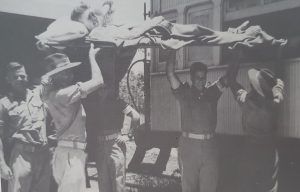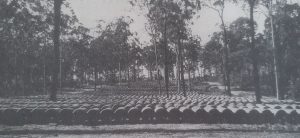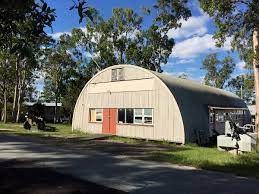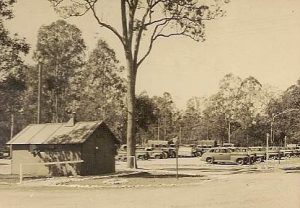
The other major use of the the Camp was a large 500-bed hospital at the corner of Grindle Road and Wacol Station Road. It was operated by the US Army 42nd General Hospital. A separate 150 bed hospital was set up at the site for Black soldiers. It was known as the Section II hospital and was an overflow from the main military hospital at the Stuartholme College.
Thousands of wounded soldiers were treated here and hundreds of military nurses were employed at the site. It also operated as recuperation hospital. A large number of patients needed to be treated for malaria.
Officer Candidate School
During 1942/1943 the Americans established the Officer Candidate School, on the other side of the railway, in the area known as Camp area 3. They provided training for nine different army branches and was of the most comprehensive schools of its kind in the world. They provide training for: infantry, field artillery, ant-aircraft artillery, engineers, ordnance, quartermasters, chemical warfare service and Air Corps Administration. The courses lasted 13 weeks. Interestingly this school was the US Army’s first experiment with the integration of Black and White students, they lived separately but studied together.
The American Non Commissioned Officers (NCO’s) who attending the school rented the Oxley Progress Hall for their club. Trucks from Wacol provided for the transport. The ‘real’ officers did of course have their own club within the Camp 3 area. It trained close to 6000 officers (of which only 152 were Black) in its short period of life and was closed in June 1945.
Counter Intelligence Corps School

There was a permanent shortage of qualified military staff at all levels among the forces in the South West Pacific Area (SWPA). To overcome this problem, they introduced a permanent Counter Intelligence Corps (CIC) training school in the SWPA theatre. At this school, agents recruited within the theatre were given the necessary training, and agents previously trained in the United States were given advanced training in subjects peculiar to the local areas. Reports received from the relatively few agents on duty in New Guinea indicated their lack of adequate preparation for combat; and, to offset this, a course was instituted at CIC Headquarters at Camp Columbia on 28 June 1943 to provide advanced training. The quality of instruction at this school was improved by experts from various Australian intelligence and field agencies.
Personnel of the Dutch CIC conducted daily interrogations of natives and other persons recently liberated; and, as a result, valuable tactical and counterintelligence information was obtained. The services performed during this operation was considered of such importance that the commanding officer of I Corps CIC Detachment was awarded the Bronze Star on 28 July 1945. Source: Counter Intelligence Corps History and Mission in World War II
After the Americans moved out in June 1944, the CIC School was mainly used by the Dutch and NEI Forces.
Camp Muckly Archerfield
The USAAF 49th Fighter Group arrived in Brisbane in October 1942 as part of Fifth Air Force, they set up a camp at Archerfield. Called Camp Muckley after Second Lieutenant Dwight S. Muckley, Jr. who was killed in a bomber crash in the Archerfield area on 5 June 1942. The unit received Curtiss P-40 Warhawks in Australia and, after training for a short time, provided air defense for the Northern Territory, before moving to New Guinea. In 1945 they became part of the occupation force of Japan.
By the time the squadron arrived in Brisbane the Army had already bulldozed a road – known as the munition road – from the Archerfield Road to Wacol Station, for which they also had to build a bridge over Bullockhead Creek.
Darra Ordnance Depot

Also the Darra Ordnance Depot was situated on Archerfield Road. The US 636th Ammunition Ordnance Company (black soldiers, white officers) was in charge of the weapons systems, vehicles and equipment and had to make sure that these were ready and available, and in perfect condition, at all times. They also managed the developing, testing, fielding, handling, storage, and disposal of munitions. It was the largest munition depot in South West Pacific war theatre. Some 70 civilians were deployed as guards on horseback around the perimeters of the Depot, including several locals. The main access was from Archerfield Road with two more entrances from Progress RD (the Wacol Gate) and the back gate on Blunder Creek Rd. There were day and night transports to the train station at Wacol or to the wharves. The site was dangerous so there were no buildings except an fire tower and a command post. The latter was situated where the old Archerfield Homestead once stood. Homestead Park is the former garden of the Homesteads.
The army groups was in 1943 assisted by the 577th Ordnance Ammunition Company, the 28th Chemical Company, the 48th Quartermaster Truck Regiment and the 5203rd Quartermaster Truck Battalion.
Camp Darra
The men of 636th Ammunition Ordnance Company manned both the Ordnance Depot and the Small Arms Renovation Plant nearby. They were housed in Camp Darra. It catered from approx 200 Black Americans. Within the camp were four large wooden huts, fifty bell tents, a parade ground and an open air picture theatre. The camp was positioned on the city side of Archerfield Road, opposite the Pine Road intersection in Richlands. With the housing shortage especially for low income earners. In 1946 a private housing co-operative was set up ‘Serviceton’ and people started to occupy the deserted army huts. The co-operative however failed and the Queensland Housing Commission took over and in 1953 the name Serviceton was changed into Inala (Aboriginal for ‘a good place to camp’).
Freeman Camp

On the corner of Archerfield Road and what is now Azalea Street (now McEwan Park) was Freeman Camp, with a guard hut on that same corner. Freeman Road to the north of it is a reminder of that camp. At this time there still was strict segregation in the USA between white and black people. The Blacks were limited to Freeman Camp, a rather ambiguous name for this place. There are many reports from locals that Blacks were treaty badly by the white officers and that they were often shot at and even killed. Locals several times hid Blacks who were chased by white officers. An estimated 200 hundred Black soldiers were camped, unlike their white colleagues they were not allowed to wear weapons. There were barracks and tents as well as a canteen, mess hall and a very large motor pool. There was also one of those famous igloo shaped hut (Nissan Hut) which was used as a picture theater and locals were always welcome to join in. As a consequence of the American segregation policy Darra was declared a ‘black’ area. Interestingly in 1945 the camp was used to again accommodate coloured people, this time Javanese awaiting repatriation home as the White Australian Policy was still in full force.
Interestingly under the ‘White Australia Policy’ Australia had tried to keep Black Americans out of the country, however the US Military ignored the government and brought in over 6300 0f them as labourers, and for use in their transport divisions. Also 152 Black people went through the Officer Candidate School.

Motor Pools
A motor pool was established at the foot of the hill on the corner of Wolston Rd and Wacol Station Road, now the Centenary Memorial Gardens. There was another motor pool at the railway station.
Emergency landing-strip and Small Arms Renovation Plant
Further to the south the Gailes emergency airstrip (now Carole Park) next to the Darra Ordnance Ammunition Depot was built by the RAAF and the US military built a Small Arms Renovation Plant next to it. There are however, no indications that the airstrip was ever used.
Charcoal Pitts
In what is now the suburb of Pallara where 8-10 small charcoal pits. They were ca. 10 by 2 meters, the military set up a hot fire than put the timber of too, cover it and let it smoulder. The timber turned charcoal and it was as needed as an alternative fuel when petrol was severely rationed.